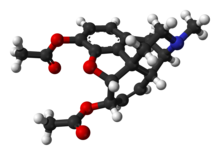Heroin
From Wikipedia, the free encyclopedia
Not to be confused with heroine.
For other uses, see Heroin (disambiguation).
 | |
|---|---|
 | |
| Systematic (IUPAC) name | |
| (5α,6α)-7,8-didehydro-4,5-epoxy-17-methylmorphinan-3,6-diol diacetate | |
| Clinical data | |
| AHFS/Drugs.com | entry |
| Pregnancy cat. | Not yet classified, but studies have shown a risk of abnormalities, hepatitis, malnutrition, and many other effects.[1] |
| Legal status | Prohibited (S9) (AU) Schedule I (CA) ? (UK) Schedule I (US) |
| Dependence liability | High |
| Routes | Inhalation, Transmucosal, Intravenous, Oral, Intranasal, Rectal, Intramuscular |
| Pharmacokinetic data | |
| Bioavailability | <35% (oral), 44–61% (inhaled)[2] |
| Protein binding | 0% (morphine metabolite 35%) |
| Metabolism | hepatic |
| Half-life | <10 minutes [3] |
| Excretion | 90% renal as glucuronides, rest biliary |
| Identifiers | |
| CAS number | 561-27-3 |
| ATC code | N02AA09 |
| PubChem | CID 5462328 |
| DrugBank | DB01452 |
| ChemSpider | 4575379 |
| UNII | 8H672SHT8E |
| ChEBI | CHEBI:27808 |
| ChEMBL | CHEMBL459324 |
| Synonyms | Diamorphine, Diacetylmorphine, Acetomorphine, (Dual) Acetylated morphine, Morphine diacetate |
| Chemical data | |
| Formula | C21H23NO5 |
| Mol. mass | 369.41 g/mol |
| SMILES | eMolecules & PubChem |
| | |
As with other opioids, diacetylmorphine is used as both an analgesic and a recreational drug. Frequent and regular administration is associated with tolerance and physical dependence, which may develop into addiction. Internationally, diacetylmorphine is controlled under Schedules I and IV of the Single Convention on Narcotic Drugs.[7] It is illegal to manufacture, possess, or sell diacetylmorphine without a license in almost every country.
Under the chemical names diamorphine and diacetylmorphine, heroin is a legally prescribed controlled drug in the United Kingdom, and is supplied in tablet or injectable form for the same indications as morphine is, often being preferred over morphine due to its lower side effect profile. It is also available for prescription to long-term users in the Netherlands, United Kingdom, Switzerland, Germany and Denmark alongside psycho-social care,[8][9] and a similar programme is being campaigned for by liberal political parties in Norway


0 komentar:
Posting Komentar